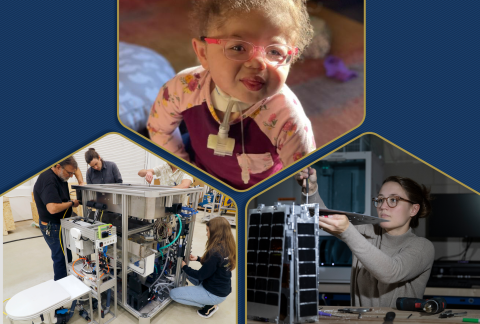For the second consecutive year, the Georgia Institute of Technology has garnered a spot among the 20 universities in the U.S. with the highest amount of research and development (R&D) spending. Georgia Tech ranked No. 20, based on the annual Higher Education Research and Development Survey conducted by the National Science Foundation (NSF). The ranking is especially significant because Georgia Tech is the only institution in the Top 20 without a medical school.
Indeed, the research funding has led to remarkable breakthroughs in biomedicine, such as 3D-printed medical devices, including tracheal and bronchial splints for children with rare, life-threatening genetic irregularities. It also has put Georgia Tech at the forefront of sustainability as researchers reimagine toilet systems that operate without inlet water or output sewer lines, improving issues with sanitation and pollution.
“We strive for knowledge, understanding, and impact in all that we do at Georgia Tech,” said Chaouki T. Abdallah, executive vice president for Research at Georgia Tech. “These expenditures also help us address our most pressing challenges here at home in Georgia, around the world, and even beyond Earth.”
The research has also taken Georgia Tech to space with a team of faculty and students guiding NASA’s Lunar Flashlight satellite probe in the quest to find frozen water on Earth’s moon. Here at home, Georgia Tech is leading a coalition of partners across the state in an effort to bring together artificial intelligence and innovation to strengthen Georgia’s manufacturing sector, create new opportunities for the state’s workforce, and augment its economic resiliency.
Georgia Tech’s R&D spending of $1.114 billion in fiscal year 2021 reflects a 6.2% increase from the 2020 figure for its entire research enterprise, which includes the Georgia Tech Research Institute (GTRI). All R&D spending in higher education increased 4% to $89.872 billion in fiscal year 2021. The nation’s top 30 schools accounted for 42% of that overall R&D spending amount, unchanged from 2020.
"We are proud to see Georgia Tech in such a distinguished group of public and private universities,” said Abdallah. “The driving mission behind all of our research is to develop and lead in creative work and innovations that improve the human condition.”
The NSF collected its data from 916 universities in the Higher Education Research and Development Survey, sponsored by the NSF’s National Center for Science and Engineering Statistics unit.
The Institute’s showing on the list of research-intensive or R1 universities places it among a group of schools that include Johns Hopkins University, which had the top spot in R&D spending with $3.181 billion, Duke University (No. 11 with $1.237 billion), and Yale University (No. 15 with $1.165 billion).
In addition to the innovations that those federal and state research dollars and foundation grants help support, the R&D funding has very real and immediate impact on Georgia’s economy. According to the University System of Georgia, all schools within the system contributed $19.3 billion to the state’s economy in fiscal year 2021. Georgia Tech’s portion of that total — roughly $4.2 billion — was the highest of any USG institution and reflects a 4.6% jump from fiscal year 2020. Learn more about Georgia Tech’s research contributions in this report.



